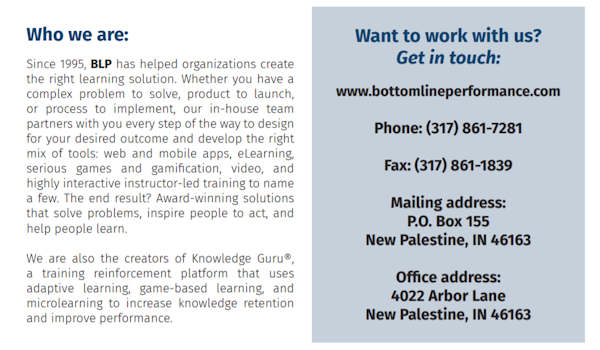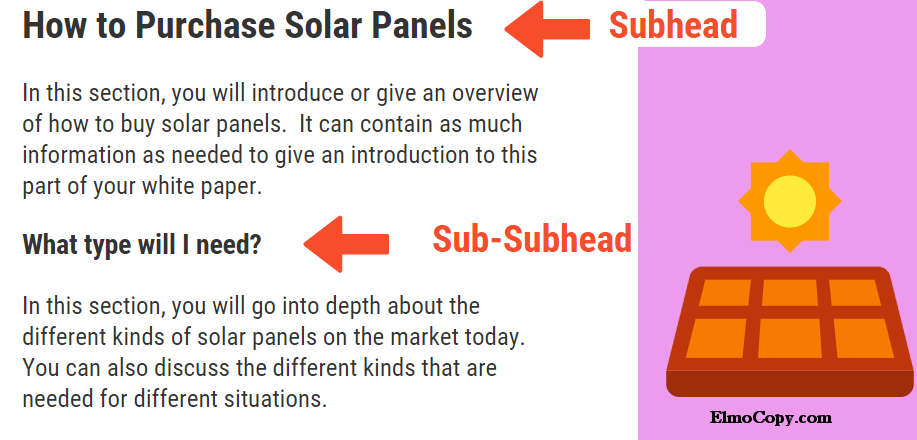This post has a white paper example you can use right now so you can generate more leads for your business.
But what is the secret to writing a white paper?
I’ll bet you have looked at a few of them and thought that you could never write one.
However, writing one of these lead generating pieces isn’t that hard. As a matter of fact, if you have a road map on how to do it, it is pretty easy.
In this post, I’m going to show you what makes a good white paper tick and how you can start writing your own.
Why You Need to Have Your Own WhitePaper
Did you know that most people who come to your website will just pop in and then pop out?
Yep, people are as impatient as a teenager behind the wheel of a car when it comes to surfing the Internet. There are so many distractions available that it’s almost impossible to keep them on your page.
But what if there was a way that you could stay on their radar AFTER they leave your site.
Would that interest you?
The best way to get your prospects to keep you in mind is to have something they perceive as valuable to download from your site. And if you are in a business that needs to generate sales for your product or service, a white paper is the perfect solution.
There are two reasons why you’ll want to have a white paper for your readers to download.
- You can get their email on the front end so you can stay in touch with them.
- They will download and keep your branded whitepaper on your hard drive for later reading.
A white paper is like an online business card, but better. You can use it as a lead for your company by showing prospects why you’re the perfect solution for them. Also, you can brand it in a way that makes it easy for them to contact you.
White papers make it easy to follow up with your prospects because you can email them later and ask them what they thought of it.
A lot of entrepreneurs give out eBooks when people land on their site. I’ve done this myself, and I can tell you that it’s a lot of work.
An eBook is a large project consisting of different chapters. A white paper is usually 5 to 10 pages in length. So, if you need a lead generator for your site fast, you can get a white paper written in 2 to 3 weeks.
Anatomy of a White Paper
I can tell you are convinced to write your own white paper. But what makes a good one?
Usually, 6 sections that make up a whitepaper. Let’s take a look at the different sections so you can see what makes them tick.
White Paper Example 1: The Headline

Your title must summarize what your content is about while captivating your audience.
If you’ve ever written a blog post, advertisement, or article, you know how important a headline or title is.
When you’re writing a white paper, you’ll want to create a working title.
A working title is a title you’re going to give your paper while you are working on it. You don’t want to write a finished one until your white paper is almost complete.
In the example above, the writer probably wrote a woking title that summarized the project while he was working on it.
It could have merely said, “Guide to Email Marketing“.
When you eventually finish your title, it should have these characteristics:
- It will position your business as the expert choice in your niche or field.
- Your title will express a subject your readers are very interested in.
- It will have an enticing element which will arouse desire and curiosity.
- The title needs to convey the idea that it will solve a problem for your readers.
Sometimes you won’t be able to get all of these characteristics into your title. However, the more of them you can use, the better.
White Paper Example 2: The Executive Summary
There are several benefits to writing a summary in a white paper.
- It will save your audience time deciding if it is worth reading
- If written well, it will create a great first impression
- Entice your reader to read more of the white paper
Just like the title, you’ll want to write the summary section after you’ve finished writing the rest of your white paper.
If you look at the white paper example above, you’ll notice that it’s targeting a specific audience.
It calls out “sales directors at discrete firms.”
There is no question about who the target market is for. So, when you sit down to write your white paper, you’ll need to think specifically who it is for and mention them in the first sentence.
If you remember what I said earlier, people on the Internet are very impatient. They need to see immediately that what they are reading is for them. So, make sure you tell them as soon as possible, otherwise, they’ll go someplace else.
2 Flavors of White Paper Summaries
Flavor #1 The Synopsis – This is a brief outline of the contents of the white paper.
It summarizes the cause of the problem(s) your reader is facing. It then highlights the problem(s) and then tells you why the usual solutions don’t work.
After that, the synopsis summary will provide a solution. Usually, the white paper will tell the reader the solution without mentioning any company names. Yes, you’ll want to get them interested in your company when it comes to the solution.
However, you don’t want to mention your business as a solution until they are finished reading it.
Why?
Because a white paper is a representation of your company’s expertise, not a slick sales letter. You want to showcase your knowledge so that prospects can draw the logical conclusion themselves that your business is the best solution.
Finally, you’ll talk about the results and the benefits of the solutions made for other individuals.
For example, if you were writing a white paper on marketing solutions for small businesses, you could talk about the faster acquisition of customers, more streams of revenue or a more efficient sales funnel.
Flavor #2 The Preview – This type of executive summary presents the problems on the front-end while not giving any solutions to them. It does tell the reader that they will explore the answers by the end of the paper. This summary like a teaser to get the readers to want to read all the way to the end.
Usually, there are 4 sections to the preview summary:
The Conditions – This part talks about how the problem came about. It addresses the sorry situation the reader has to deal with daily. (You know you got this part right when the reader nods in agreement as they are reading.)
Assessment – In this part, you are going to summarize the problem(s). You’ll explore why the usual methods or actions are failing. You can also promise that the answers will follow if they read on.
The Effects – Next, talk about how the problem is taxing or damaging the reader’s life. For example, if you are writing about a business subject, you will talk about how the reader is losing revenue every month. If you were writing about a health issue, you could talk about the types of diseases that are impacting lives over time.
The Promise – Finally, give the reader hope of a better tomorrow. You are going to tell them that there is a solution to their problems. You do not want to say you have the answers, but just let them know if they read to the end, you will share with them what the fix is. Since your white paper will have all of your company’s branding on it, they will automatically understand that your business specializes in fixing the problem discussed in the white paper.
White Paper Example 3: The Main Body
Most writers will use an outline while they are writing.
My method is to write out a draft of a summary first so that I can brainstorm and pull together ideas I’ve gotten from resources. I’ll go back and get ideas from it for most of my outline.
I know of top-level copywriters who will tell you that you should write your summary last. Whichever way you want to do that is up to you. You can create an outline first if you want to.
At any rate, you will need a completed outline to guide you on your mission to write an excellent white paper. One of the reasons why it’s so important is because you can get lost or start chasing ideas that are irrelevant to the mission of the white paper.
Another reason why you want a well-written outline is that it will help you set up your subheads. What are subheads? Here is our next example so you can see what they are:
Subheads are like headlines or titles that run down the page announcing each new section. (I’ve got subheads running down this post. If you don’t believe me, scan it.)
A famous copywriter once said that subheads are like mini-power stations because they keep you interested in moving down the page. (Kind of like electricity moving across power lines.)
Not only can you have subheads but you can have subheads within subheads or sub-subheads. (Once again, please look at the sample above.)
White Paper Example 4 Writing Each Section
If you have to write a long white paper, you can get lost in your ideas. That’s why I told you to write out your subheads and sub-subheads first.
Once you place them in a logical order writing your white paper will be a lot easier. If you’ve ever written a blog post or a chapter of a nonfiction book, you’ll know what I mean.
Each section under your subheads should discuss the importance of the subject you’re writing about. You could then write about the problems associated with the subject.
Once you’ve detailed the problems, your white paper can offer solutions.
However, it’s a little more involved than that. Let’s look at a template for a section, so you can see what I mean.
Subhead Title
Brief Summary – Summarize the section by telling what it is about. You can mention that you will be discussing some of the problems that can arise from your subject.
Examine the Problems – Your next paragraph(s) could examine the problems associated with the subject in more detail.
- Give details on why you think this is a problem.
- Show historical data on the issue so your readers can see how it all came about.
- Use visual aids to make your facts and data clearer.
- Using your facts and data, tell your readers how you came to your conclusions that these are significant problems.
Provide Solutions and Ideas – You’ll want this next part to show how the problem discussed in this section can possibly be fixed.
Here are a few ideas on how to make that more concrete and interesting:
- Discuss your points and how you think they could be used.
- Use sub-subheads to announce each different point.
- You can also use bulleted lists to make your points clearer.
Defend Your Position – Give evidence as to why your solution is the best one possible. Give stats, data, refer to case studies from reliable sources, etc.
White Paper Example 5: Conclude with Solutions or Steps
Once you’ve fleshed out most of the issues involved with your main subject, you’ll want to conclude with some solutions or steps.
I want to caution you on how you handle this. If you start bragging about how your company is the solution to your reader’s problem, you’ll look like a salesman. I’ve seen white papers that do this and they look like sales letters.
Companies that do this are taking the risk of ruining their white paper.
If you have branded your white paper with your company’s contact information, they will see you as the solution to their problem.
However, you want them to make the decision on their own that you are the best choice. If your white paper resonates with your audience, you will not have to try to convince prospects to call you.
There are several different ways to conclude your white paper.
The best ones I have seen briefly restate the problem in a way that makes the reader feel you understand what they are going through. You don’t need to write a lot, just a sentence or two.
After that, they offer steps that can be taken to get rid of the problems in the white paper.
Other white papers simply highlight the solutions and show how these solutions will solve the reader’s problems.
White Paper Example 6: An Acceptable Way to Talk About Your Company
Remember earlier when I told you earlier that you should avoid talking about your company?
The reason why I told you that is because it will make you look like you’re trying to sell your services.
You know what I mean. You don’t want to look like one of these guys…
There is an acceptable way for you to do this.

You can either write an “About Us” or a “Who We Are” section like the excellent one above from Bottom Line Performance.
The main thing you do not want to do in this kind of a section is to overtly sell your services. You merely want to tell your readers who you are and what it is your company does. You don’t want any “Buy it Now” calls to action or anything like that.
If your company already has an “About Us” page, you can copy, paste, and format your information into the white paper. It is OK to put your company’s contact information into your white paper. Savvy white paper readers will already know that your company is the solution to their problem without your trying to sell them.
Conclusion
White papers are a powerful way of generating leads for your business.
Great care needs to be taken in creating one. If you do not feel like you or your staff are up to the task, perhaps hiring a copywriter will be your best solution.
When you think about how many people could potentially read your white paper, you will understand just how important and vital it can be in your business’s marketing plans.







